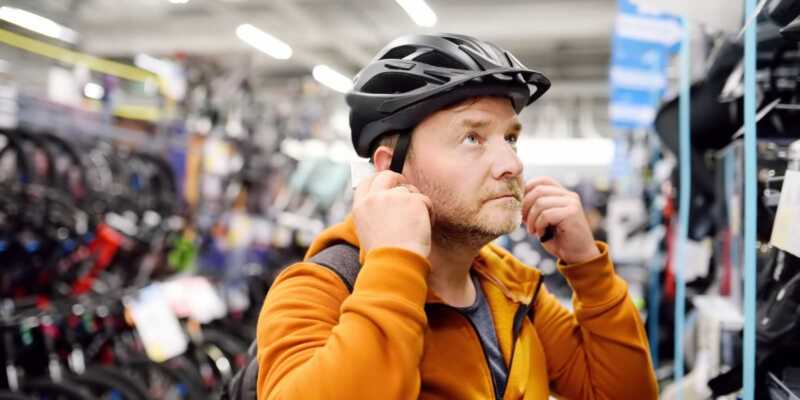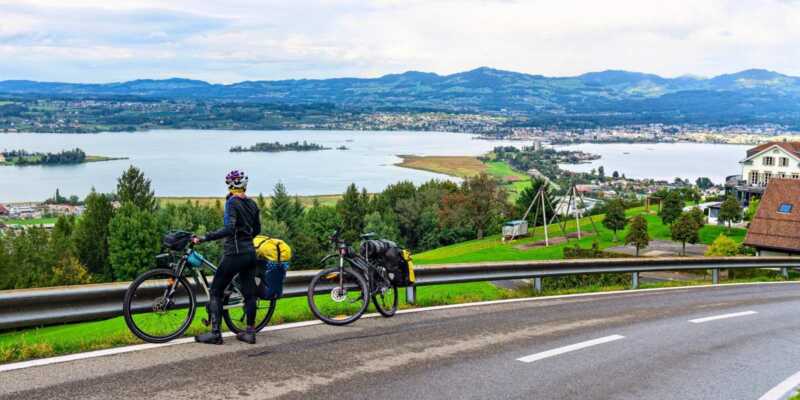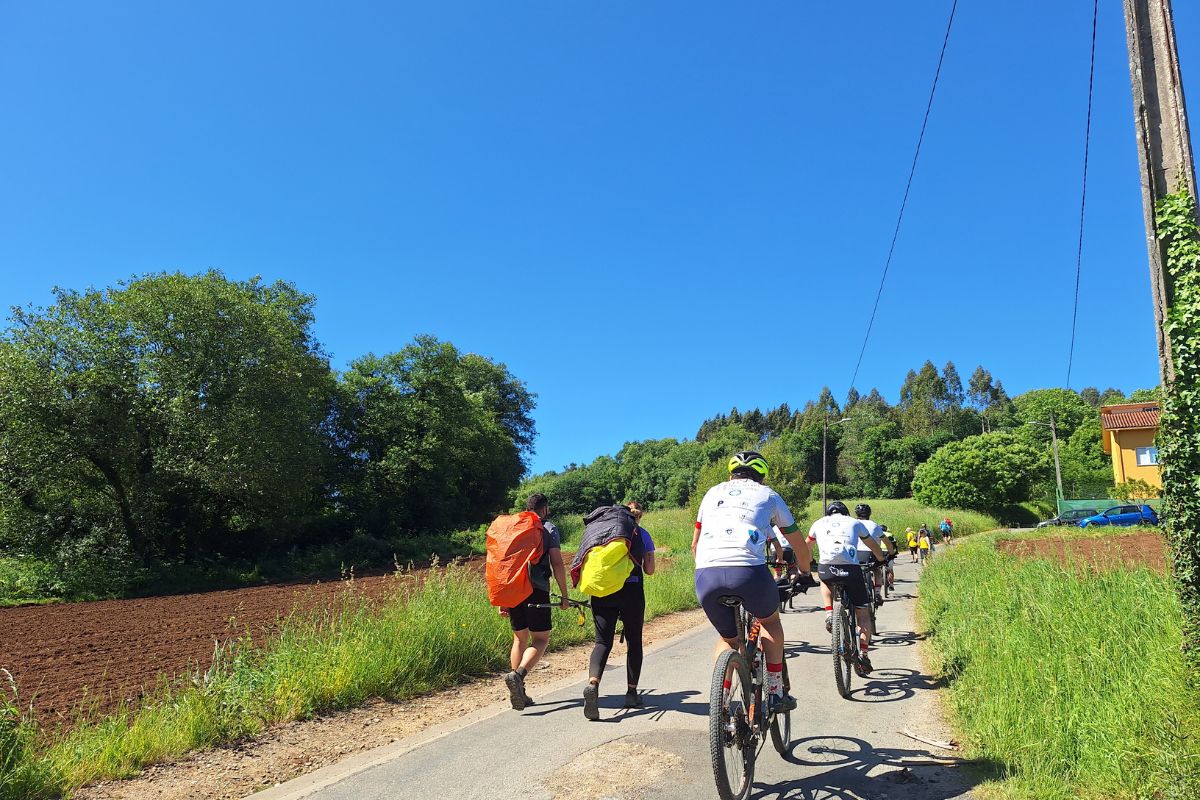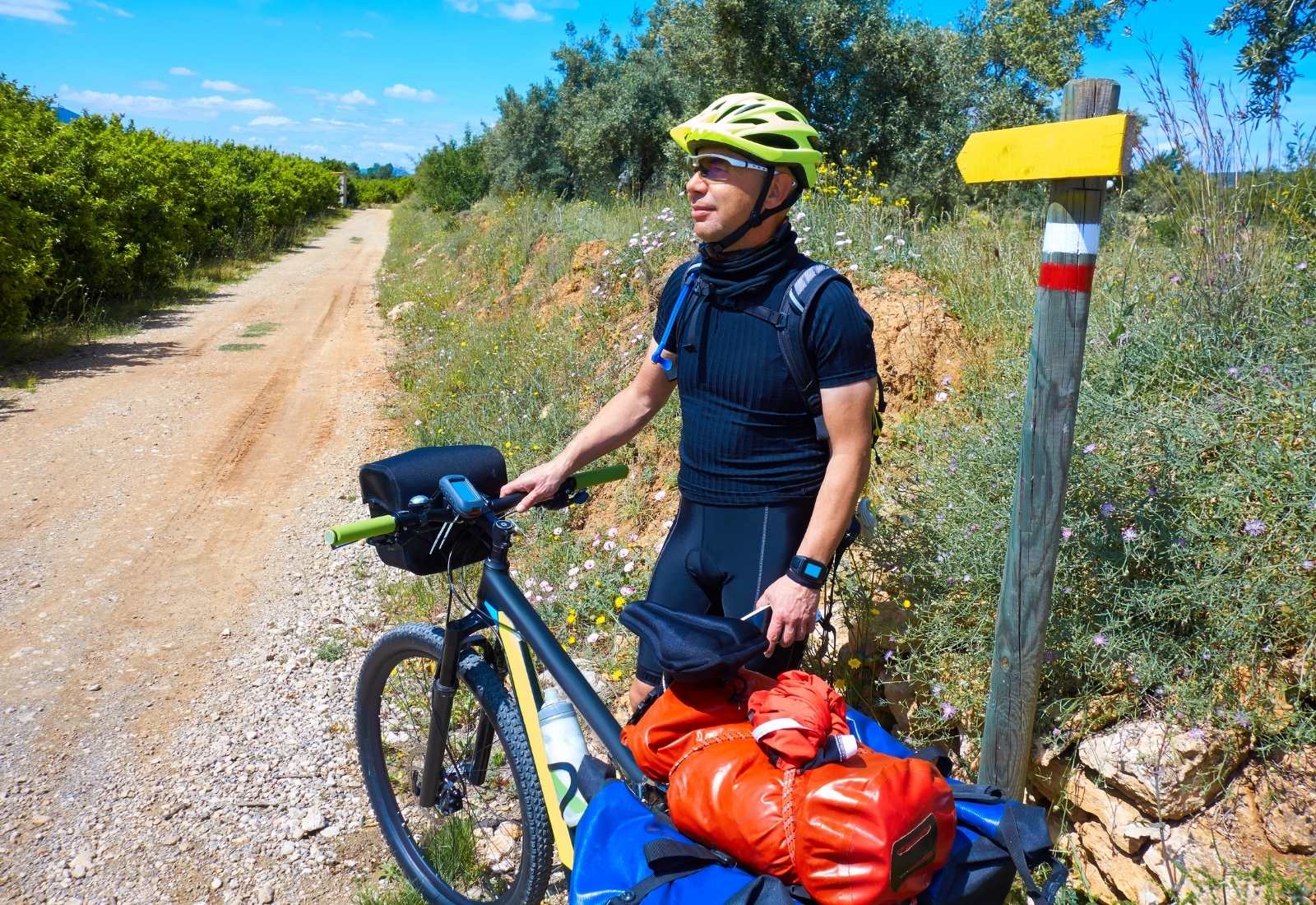Cycling any of the Jacobean routes is truly a great plan for holidays or days off, especially if you’re a fan of pedaling. One of the advantages of doing the Camino de Santiago by bike is that you can cover a greater number of kilometers in less time, allowing you to complete most of the routes in one or two weeks. Here are some beginner tips you’ll need if you want to do the Camino de Santiago by bike.

Pilgrims on the French Camino enjoying the stage
Doing the Camino by bike
Many people insist on doing the Camino by bike without having enough technique or experience in mountain biking. The truth is, this journey has nothing to do with a one-off weekend trip. Keep in mind that for at least a week, you will be pedaling a considerable number of kilometers through forest tracks, roads, and paths often in poor condition, with steep ascents and descents that will test you more than once. In addition, there’s the accumulated fatigue as the days go by, not to mention the added weight of your luggage in the panniers. If this is your first time as a “bicigrino” (bike pilgrim), our recommendation is that you assess your physical condition, train beforehand, and consider your experience as a cyclist before embarking on the Camino de Santiago adventure.
Tips for doing the Camino by bike
Here are some tips that will make things much easier when doing the Camino de Santiago by bike.

A bike on the Camino de Santiago
Choose and study the Camino de Santiago route you’ll be taking
Choose your route carefully, keeping in mind that it can be as demanding as you want. You can cover 800 km in ten days, with stages between 80 and 100 kilometers, or do it in a month with stages of 50 km. But the difficulty doesn’t only lie in the length of the stages, but also in the terrain’s topography: it’s not the same to cover vast plains as it is to climb steep mountains. And remember: if you want to earn the Compostela, you’ll need to cover at least the last 200 km with arrival at Santiago de Compostela.
For this reason, you should never set a linear goal of “x” kilometers per day, since each stage’s profile varies considerably. Always translate distances into hours and don’t obsess over kilometers. Ideally, you should aim for 6 hours of pedaling a day. Keep in mind that this isn’t a one-off outing, but the next day you’ll have to get back on the bike, and the next, and the next… so physical fatigue builds up, and it’s important to manage your energy to keep up the pace throughout the journey.

The Camino de Santiago also has signs for cyclists
Equip yourself well
Pay attention to the weather and prepare your gear accordingly. Keep in mind that you’ll be spending many hours on the bike, so it’s essential that the shorts you wear have good protection. Don’t forget a good helmet, proper footwear, sunglasses, sunscreen, and above all, a good repair kit and tools. If needed, here’s a list of essential gear for doing the Camino de Santiago by bike:
- Cyclist clothing: Includes breathable t-shirts, jerseys, cycling shorts, leggings, windstopper jackets, and shoe covers, all designed to adapt to the climate and keep you comfortable and protected during the ride, especially in case of rain.
- Footwear: Cycling shoes with clips are recommended for added security, with soles designed for walking, plus rest shoes for after the stages, and sandals for showers and foot rest.
- Accessories: Essential for the safety and comfort of the cyclist, such as a helmet, gloves (winter or summer depending on the climate), a cap or hat to protect from the sun, sunglasses to protect from sun and dust, and a neck gaiter or scarf for cold weather.
- Bike accessories: Includes panniers to carry your luggage, elastic bungee cords to secure items, lights for visibility, a lock for security, a speedometer and heart rate monitor for more advanced cyclists, an extra water bottle, and a multi-tool kit for repairs.

Prepare yourself well before hitting the road on the Camino de Santiago by bike
Bike check-up and maintenance before starting your journey
It’s very important that before starting your journey, you check the condition of your bike, especially if you haven’t taken it out of the garage for a while. Simply adjusting the brakes, wheels, and transmission should be enough for a basic check-up. You can take it to a shop or ask a friend to help you, and this way you’ll avoid a lot of headaches and be able to fully enjoy the experience.
Additionally, when doing the Camino de Santiago by bike, it’s crucial to know a bit of bike mechanics, although it’s true that on popular routes like the French Camino, Portuguese Camino, or Northern Camino you’ll find many bike shops and specialized workshops. However, unexpected breakdowns can always happen, and not knowing how to fix them could ruin your trip. Therefore, before setting off, we recommend that you learn at least these four things:
- Fixing a flat tire.
- Adjusting brakes.
- Adjusting gears.
- Lubricating the chain.

You don’t need to be a “handyman,” but you should know the basics for dealing with a breakdown on your bike
Don’t carry too much luggage
Being well-equipped doesn’t mean stuffing your panniers to the brim. Choose carefully everything you need and avoid unnecessary items in your luggage. Carrying excess weight will be noticeable with every pedal stroke, affecting your endurance and your mood. More than one pilgrim has had to abandon their belongings halfway through to lighten the load.
A good option to enjoy the Camino even more is to hire luggage transport service and forget about carrying the weight. Every morning, you can leave your backpack or suitcase at the accommodation’s reception, and a vehicle will take it to the end of your stage, so when you arrive, your suitcase will already be waiting for you. Remember, the luggage transport service is included in all our bike tours.

It’s recommended not to overpack when doing the Camino
Priority in hostels
If you plan to do the Camino de Santiago by bike and stay in public hostels, you should know that beds are assigned strictly by order of arrival at the establishment. Pilgrims with physical limitations have priority, followed by those walking, then those riding horses, and finally, “bikegrims.” This doesn’t mean you won’t find accommodation, but you should keep this in mind when planning your trip, especially in high season when hostels reach full occupancy.

Pilgrims and “bikegrims” coexisting harmoniously on the Camino
Enjoy the experience
Although it may seem obvious, the truth is that we often forget that the Camino de Santiago by bike is not a race and it’s not important who arrives first at the end of the stage. As you’ll know, on a bike, you perceive things differently than when walking, as you go much faster than a pilgrim walking. Take note of the interesting places on each stage, visit monuments, stop to admire the landscape, or enjoy a relaxing conversation with those around you—wonderful things always happen. The adventure of the Camino de Santiago, which you can even do on an electric bike, offers numerous physical, emotional, and spiritual benefits, and it would be a shame not to enjoy them to the fullest. However you choose to do the Camino, remember, we can help you.












Leave A Comment